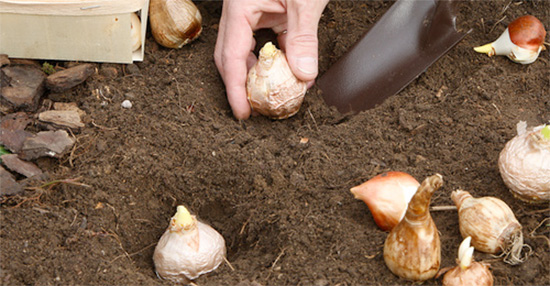Spring-flowering bulbs can be planted from September through December. What a nice way to add early colour to your garden, patio or balcony every spring. Planting spring-flowering bulbs means being able to start enjoying profusions of flowers early in the season. Snowdrops, crocuses, narcissus, tulips and hyacinths – these are the harbingers of spring in your garden, balcony or patio.
Each kind of bulb has its own flowering period. By being aware of this, you can start enjoying flowering bulbs very early in the year. The first to emerge are the winter aconites and snowdrops – the traditional harbingers of spring. Next come crocuses, Glory-of-the Snow (Chionodoxa), narcissus, the first early tulips, and the impressive Crown Imperial (Fritillaria). Alliums will flower from mid-May until far into July. As you can see, making the right choices lets you enjoy wonderful colour for six months of the year.
-
Planting
Before planting, loosen the soil thoroughly. You might also want to work some compost into it. Then dig a hole and arrange the bulbs in an upright position in the hole. (Small bulbs can simply be tossed in.)
-
When to plant
Spring-flowering bulbs can be planted from September and on into December, but try to plant them before freezing weather sets in.
-
Planting depth
The general rule of thumb for the planting depth is to plant a bulb twice as deep as the bulb is tall. For large bulbs such as narcissus, tulips and hyacinths, this will be about ten to twenty centimetres deep. For smaller bulbs such as snowdrops and crocuses, this is about five to ten centimetres.
-
Planting distance
Large bulbs need more space between them than small ones. Plant large bulbs an average of twelve centimetres apart from each other, small bulbs an average of five to seven centimetres apart. The spacing interval (or, another way of looking at it: the number of bulbs per square metre) also depends on the visual effect you want to achieve. For a casual, natural-looking effect, plant the bulbs at varying distances apart and don’t hesitate to put one or two somewhat farther away. If you want a solid-colour floral carpet effect, plant all the bulbs at the same distance apart.
-
Soil type and drainage
Sandy soils drain off rainwater fairly quickly. Clay soils tend to retain moisture longer. Because bulbs don’t like soggy conditions, you may want to take extra precautions if you have a clay soil: lighten the soil by mixing sand or compost into it or sprinkle some small pebbles into the planting holes before putting the bulbs into them.
-
Water and frost
Water the bulbs immediately after planting. This encourages them to produce roots. The sooner the roots have developed, the sooner the bulbs can tolerate cold and frost.
Flower bulbs in pots and containers
Patios and balconies are increasingly being seen as an extension of the living room. During the summer, you can look out over flowering tub plants and annuals in pots and containers. In the spring, flower bulbs provide the colour
Planting flower bulbs in pots and containers is easy to do. Choose a pot large enough or container with drainage holes at the bottom. Place a few potsherds or some ceramic granules over this hole. This way, excess water can escape easily. Then put potting soil into the pot or container until it reaches the right planting depth for the bulbs. Arrange the bulbs on top of this soil and add more potting soil until it reaches just below the rim of the pot. Bulbs in pots and containers can actually be planted more closely together than if you were planting them in the garden soil. Doing so makes for a prettier effect. For a varied, more natural look, try taking advantage of contrasting flowering heights.
Tip 1
Flower bulbs can tolerate cold winter temperatures. But don’t plant them too closely to the side of the pot because this is the very the place where frost can penetrate. If a very hard frost is forecast, you could wrap the pots with an insulating material such as Bubble Wrap or place them temporarily in a spot that will not get any warmer than 13˚C (55°F)
Tip 2
Terracotta pots can crack during the winter due to the expansion of the soil inside them during freezing weather. You can prevent this problem by planting the flower bulbs in a plastic pot that can be placed inside the terracotta pot. Once again, make sure that any excess water can drain off. During a hard frost, you could fill up the space between the two pots with insulating material.
Planting in layers
You can plant flower bulbs in layers (also known as the sandwich or lasagne system) in your garden as well as in pots and containers. Bulbs that flower latest in the season (such as tulips) are planted in the lowest layer. Bulbs that flower earlier – such as crocuses or grape hyacinths – are planted above. Planting in layers will have no adverse effects on the bulbs. They will simply flower one after another in the same spot. So the same pot or container will provide flowers for many weeks.
Enjoying your bulbs again next year
Many bulbs can be left in the soil after flowering. Just leave them alone and let the leaves wither back on their own. Next year, these same bulbs can produce another beautiful display, but you will have to help them along by providing fertiliser. Apply this fertiliser (either organic or inorganic) when the shoots emerge from the soil, and repeat the procedure immediately after flowering.


